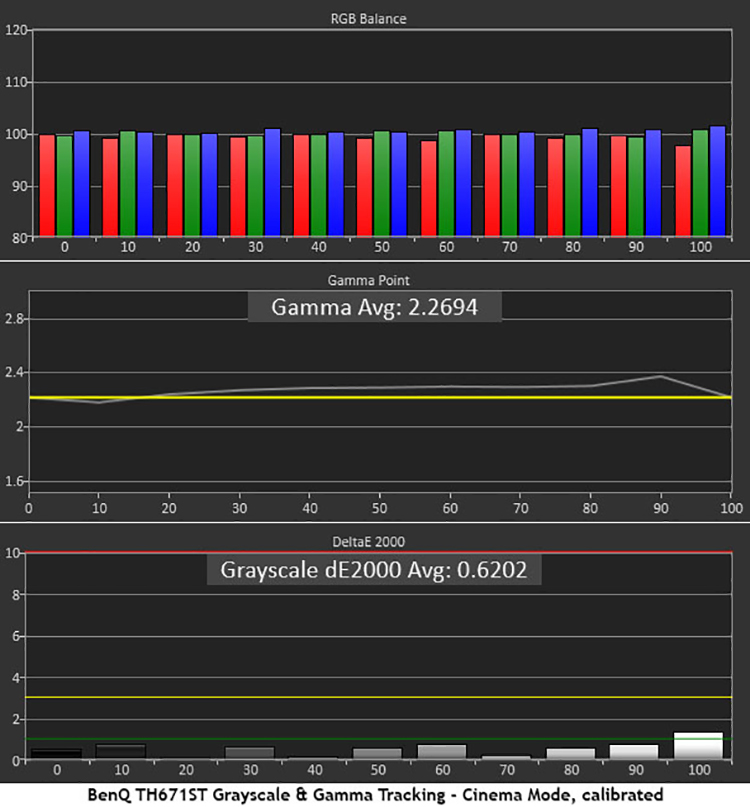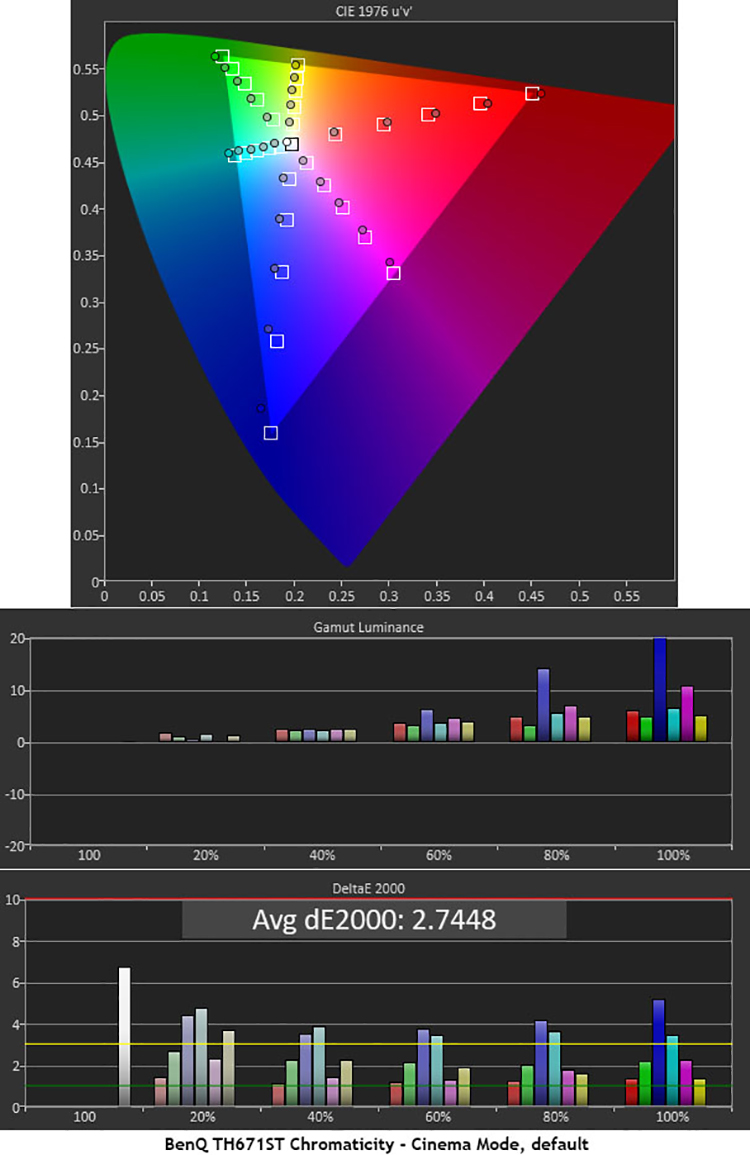As a home theater publication Secrets naturally looks to review products that provide the best movie experience. But many enthusiasts want their rooms to do more than just screen the latest Hollywood blockbusters. Gamers need low input lag and a bright image, which BenQ’s TH671ST DLP Projector can deliver. With 3000 lumens from a small, lightweight chassis, it’s the ideal display for movies, TV shows, streaming, and gaming. It’s a short-throw design which means it will fit into smaller spaces. At a projection distance of just five feet, it can display a 100” diagonal picture on your screen or wall. To that it adds 3D support and accurate, Rec.709 color. A single-chip DLP light engine ensures the sharpest possible image and it sells for a very reasonable $749 MSRP.
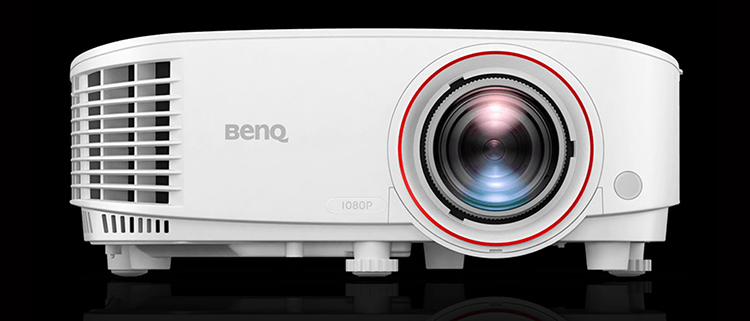
BenQ TH671ST DLP Projector
- 3000 lumens peak output
- 3D support
- Short-throw design delivers a 100” picture from just five feet away
- Built-in five-watt speaker
- Low-input lag suitable for gaming
- Accurate Rec.709 color
- Full suite of calibration options
BenQ continues to impress me with its compact DLP offerings. I’m happy to review anything they wish to send me and today, I’ll be looking at a short-throw, low-input lag model, the TH671ST. It may be tiny but it’s capable of 3000 lumens output, supports 3D, and has a low-lag mode perfect for high-speed gaming. Lest you think its movie chops have been compromised, fear not. Like nearly all BenQ’s projectors, it features accurate Rec.709 color. In fact, it’s out-of-box measurements in Cinema mode don’t require calibration. That’s astounding in a $749 display. Of course, the controls are there and I plan to use them.
Light engine:
single-chip DLP
Color wheel:
2X, RGBYCM
Native resolution:
1920×1080, 16:9 aspect ratio
Native color gamut:
92% Rec.709
Input lag:
16ms
3D:
frame-sequential, top/bottom, side-by-side
Throw ratio:
.69-.83
Image size:
30-300”
Lens offset:
102.5% above lens axis
Lamp:
UHP, 240w
Light output (mfr):
3000 lumens
Video connections:
2 x HDMI 1.4 (1 x MHL), 1 x VGA in, 1 x VGA out
Additional connections:
RS-232, 2 x USB, 3.5mm audio in/out
Speaker:
1 x 5W
Lamp service life:
4000-15,000 hours
Dimensions:
11.65” x 4.72” x 8.82” (WxHxD)
Weight:
5.95lbs
Warranty:
Three years
BenQ TH671ST DLP Projector Price:
$749
Company:
SECRETS Tags:
BenQ TH671ST, BenQ, DLP Projector, Compact DLP, Gaming, 3D, Short-throw, Projector Reviews 2018
I’ve reviewed plenty of compact projectors and pointed out their features, but one area I haven’t spoken much about is gaming. Modern media rooms often include a gaming console or PC and that requires a more specialized display. Beautiful pictures are great and all, but a gamer needs speed above everything. I’m not talking about the high refresh rates seen in today’s gaming monitors, projectors are still limited to 60Hz. But when the action ramps up in intensity, a player needs a projector that will respond instantly to control inputs. Low input lag is often the key to victory. To that end, BenQ has included a low-lag mode in the TH671ST. In addition to my usual tests for color accuracy and video processing, I’ll perform an input lag benchmark using a high-speed camera. It looks like another impressive compact DLP from BenQ. Let’s open the box and take a look.
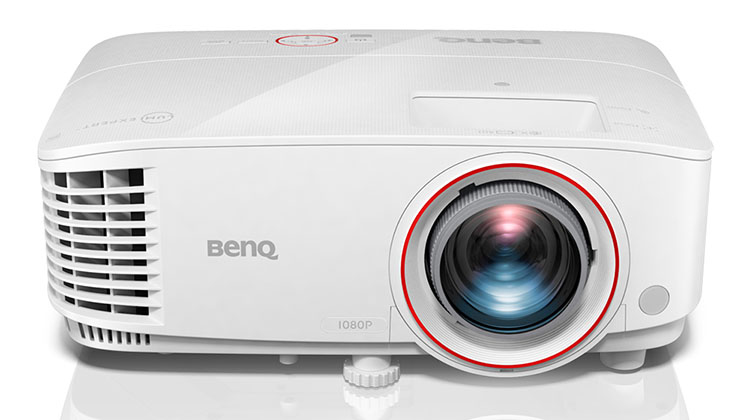
The TH671ST uses a single-chip DLP light engine from Texas Instruments. The color wheel spins at 2X speed with an RGBYCM configuration. I wondered if it would be fast enough to prevent rainbows and it clearly is. Though some BenQ models use 4 and 6X wheels, this one did not create any visible artifacts in my experience.
Secrets Sponsor
The short-throw lens is offset from center and surrounded by a nice red trim ring. Its front element is more rounded than typical optics to ensure a square image at short distances. A zoom ring up top takes the throw ratio from .69 to .83. At around five feet away, the picture is 100” diagonal. Offset is 102.5% which means you’ll need to set up the TH671ST slightly below the edge of your screen. This makes it perfect for small living rooms where one might put the projector on a coffee table. It can also be hung from the ceiling. If you don’t have a screen, the wall can work too and BenQ has provided color offsets for that purpose. If you need to further adjust geometry, there are two leveling feet in back and one up front. You can also use the keystone correction feature.
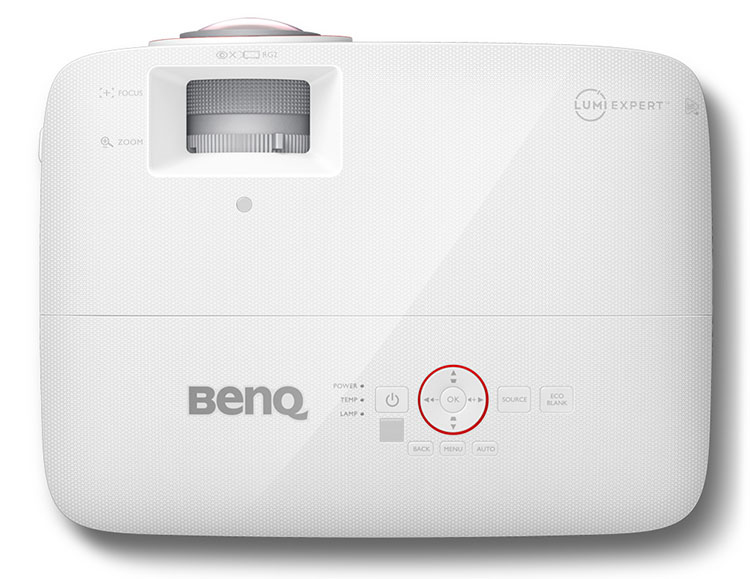
Ventilation is generous with a quiet fan that I could barely hear at its top speed, impressive considering the bulb is 240 watts. There is a bit of light leakage from the grill and from the lens controls on top. That’s where you adjust zoom and focus with firm precise movements. Also up here are basic control buttons for power, menu navigation, and source selection.
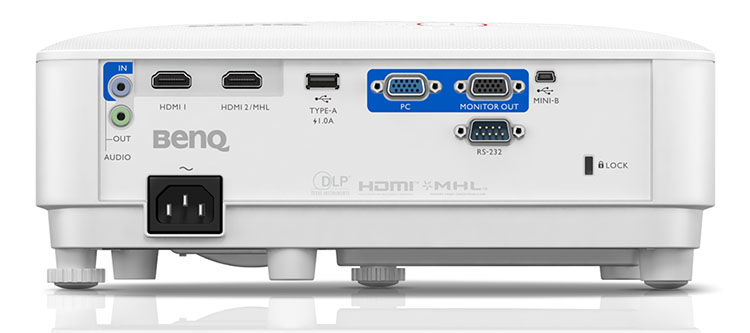
In back is a well-stocked jack panel with two HDMI inputs, one of which supports MHL. You also get VGA in and out for connecting to older computers. Control is possible through the RS-232 port and there is an IR sensor up front by the lens. The small sensor on top is for ambient light and works with the TH671ST’s LumiExpert feature which adjusts gamma based on your room lighting. I’ll explain that further in the next section.
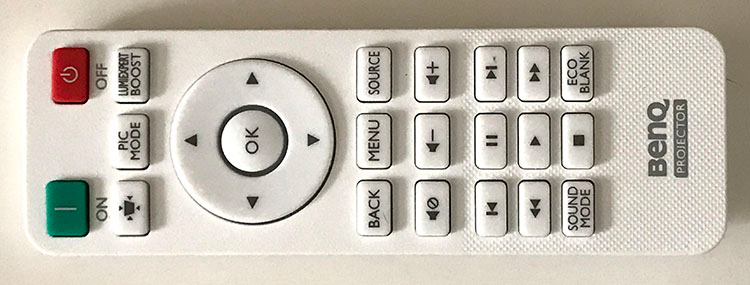
The remote is tiny and lacks a backlight, but has all the basic functions one would need along with transport keys for MHL source devices. It’s perfectly fine for setting up projector and navigating the menus but it’s a little hard to operate in the dark.
Secrets Sponsor
The TH671ST supports 3D courtesy of DLP Link. BenQ offers glasses at additional cost or you can pick up aftermarket models online. I used my usual pair from Xpand without issue. They synced immediately when 3D content was detected.
The TH671ST’s menu system is just like the one I’ve encountered on many previous BenQ projectors. If you want to avoid the detailed settings, just choose the Basic version which only gives you, well, the basics like input selection, picture modes, and the like. Tweakers and videophiles will want to choose Advanced for full access to all the calibration controls and features.

First up are five preset picture modes, all of which can be calibrated. Or choose one of the two User slots, pick a preset as its starting point, and create your own configuration as I did. You can rename it when you’re done. Cinema is the best starting point whether you calibrate or not. There is a separate mode for 3D signals which is also fully adjustable.
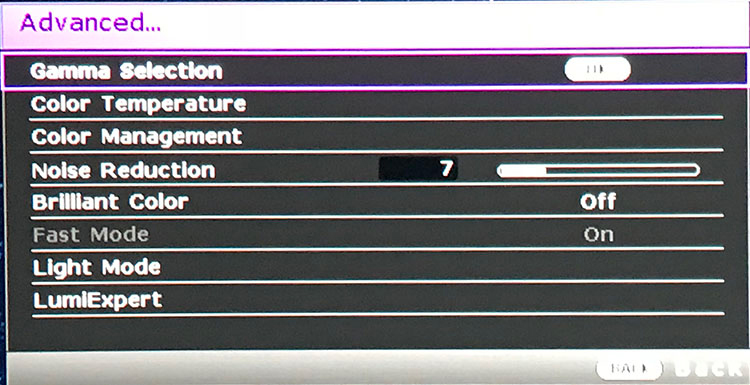
All the important stuff is in the Advanced sub-menu. There are nine gamma presets which offer fine control and excellent accuracy. I chose 2.3 for its slightly better mid-tone contrast and color saturation. Color Temperature comes in four flavors, all of which are adjustable with gain and bias sliders; Normal comes closest to D65. You also get a color management system with hue, saturation, and gain (luminance) sliders for all six colors.
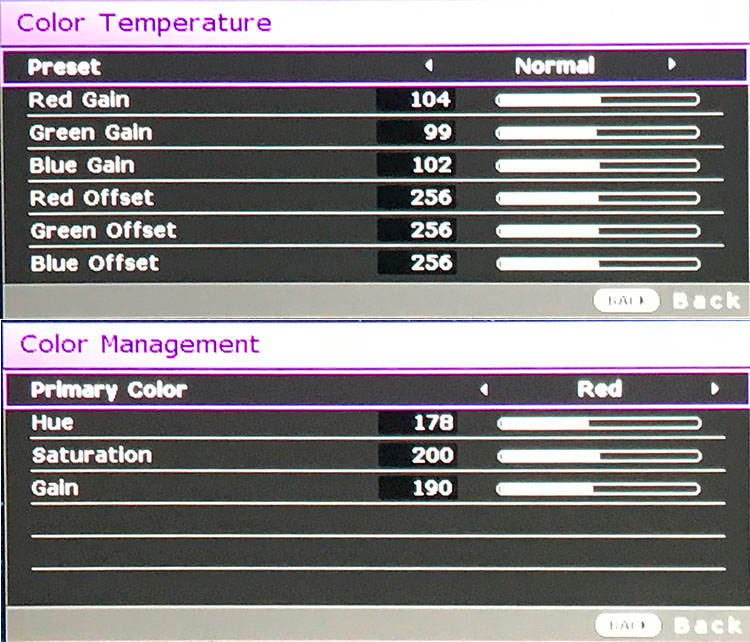
Brilliant Color is a feature I’ve seen on pretty much every BenQ projector and it works differently with each model. The TH671ST’s implementation is subtle. You can barely tell a difference between the on and off setting. Ultimately, I preferred the picture with it left off.
Fast Mode is the input lag control and you can leave it on all the time if you wish. It lowers latency and doesn’t affect normal video content in any visible way. It will certainly improve the gaming experience though.
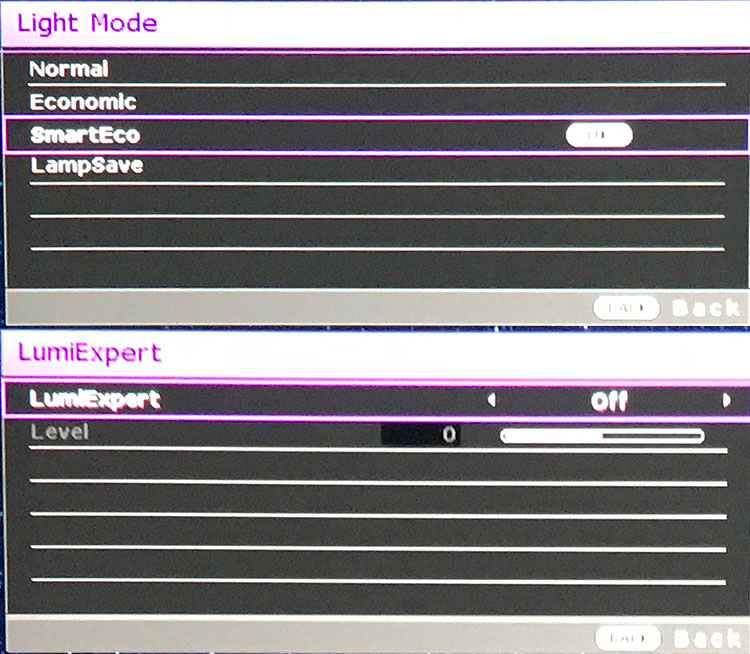
Light Mode contains the four lamp levels. Normal is brightest followed by Eco which cuts output by about 35%. SmartEco throttles brightness and roughly doubles static contrast with occasionally visible image pumping. LampSave also varies output and extends lamp life to a claimed 15,000 hours.
LumiExpert is something I had not seen before. It works with an ambient light sensor on the chassis’ top and adjusts gamma on the fly according to your room’s lighting. In my test, it had a very subtle effect but I found better quality in my totally dark space with it left off. You can adjust the amount of compensation with a six-position slider.
Installation was simple as always. I connected a cable to HDMI 1 and used that input for all testing and viewing, which I did with an OPPO UDP-203. I calibrated the Cinema mode to a very high standard and engaged the SmartEco lamp mode once adjustments were complete. I left Brilliant Color and LumiExpert off and set gamma to 2.3 for a tad more punch. With that done, it was time to watch a few movies.
2D Blu-rays

I had just watched the Ultra HD version of Kingsman: The Golden Circle, so I thought it would be interesting to check out the standard Blu-ray. Obviously, the color and contrast was significantly, well, less. But clarity and resolution barely showed a difference. I believe a DLP projector with good optics like the TH671ST can compete very favorably with all but the very best Ultra HD displays. Black levels aren’t as deep as those you’ll find in LCD or LCoS models but highlights pop so effectively, it almost doesn’t matter. And motion quality is noticeably smoother with less loss of resolution as objects begin flying. The BenQ’s accurate color was apparent when the scenes in Poppy’s hideaway which feature a particularly bold shade of red. It’s a unique color in both formats and the TH671ST had no trouble rendering it and the fine detail within.
Kong: Skull Island is a reference Blu-ray in its HD version. Here, I looked for the warm colors of the seventies as the characters visit a strange place filled with horrific CGI monsters. Not only did details like Kong’s hair pop right out, the image had lots of depth despite a flat color palette. Though much of the scenery appears shot through a filter, I could always see the finest textures and most subtle elements. Superior motion quality was again evident as objects flew with lightning speed across the screen without even a hint of blur.
Passengers is one of the more digitally-scrubbed titles I’ve seen recently. It’s a great looking disc and it shone on the BenQ. Much of the palette is metallic but the warm tones of the ship’s bar and character’s skin looked just right, natural and properly saturated. Color accuracy is still important even in the age of new technology and the TH671ST gets it right, with or without calibration. I switched to an unadjusted mode just to see and the difference was small. While I always recommend going for the highest possible quality, those who don’t chose to calibrate won’t be disappointed in the image.
3D Blu-rays

3D is still a thing with some enthusiasts and BenQ always provides a good experience. The TH671ST is a little brighter than most and that just makes it all the better. Upon putting Cloudy With A Chance Of Meatballs in the player, the projector switched immediately to its 3D picture mode. This CGI animated feature is simple in texture but abounds with bright saturated colors. I never wanted for more contrast and the depth effect was clean and clear with no ghosting artifacts or motion blur. DLP is still my favorite technology for watching 3D and BenQ doesn’t just include it as an afterthought.
Sticking with the classics, I watched Avatar for at least the hundredth time. I always enjoy this film in its 3D version because of its sense of scale. Watching Jake Sully wheel out of a huge spaceship and past enormous mining equipment makes my 92” screen seem much bigger. While nothing compares to seeing this movie in 3D IMAX, a good home theater setup with the TH671ST in it is a close second. While 3D may have passed its fad point in the consumer marketplace, there are still people, like me, who enjoy a good presentation. BenQ obviously cares about these people and continues to offer products that satisfy.
To test the TH671ST’s color accuracy, I used an X-Rite i1 Pro Spectrophotometer facing the projector’s lens and fitted with its diffuser attachment. Luminance readings were taken with a Spectracal C6 tri-stimulus colorimeter facing a 92” diagonal Stewart Filmscreen Luminesse with Studiotek 130 material, gain 1.3, at a 10-foot distance. Patterns were generated by an Accupel DVG-5000 and controlled with CalMAN, version 5.7.
In Cinema mode, the lamp defaults to its brightest setting and Brilliant Color is turned off. I used that preset as a basis for my own custom memory. There are two slots, User 1 & 2, that can be set up and renamed to the user’s preference.
Out-of-box accuracy is good, especially in the gamma tracking department. There, you can see a near-perfect adherence to 2.2. My only complaint is there’s no BT.1886 option. I’ve found this spec makes low-contrast displays like this look a little better with more emphasis on mid-tones. Whites look slightly green but it’s easier to see that issue in test patterns. Real-world content will brook no complaint from most users. Errors rise along with brightness so if you watch a lot of high-intensity material, a calibration will help improve image quality.
Turning on Brilliant Color will slightly improve grayscale accuracy but I used the RGB gain and bias sliders instead. A few tweaks of the gain controls delivered excellent grayscale tracking and only a slight shift in gamma. After checking out a few film clips, I decided to bump the preset to 2.3. It rides a little darker on the chart but the image looks far better with noticeably greater perceived contrast. Color seems a bit more saturated as well, and that’s supported by my gamut measurements below.
We’ve reached a great time in video display history when a $749 compact projector renders Rec.709 color with an average error of just 2.74dE out of the box. It wasn’t long ago when I’d be happy to achieve that number after a two-hour calibration of a $5000 product. The industry has come a long way and BenQ is offering tremendous value here. All measurements are on or near target and the only color that comes up a tad short is blue, which is slightly under-saturated. With a little luminance compensation from the CMS, that issue can be easily overcome. Not only does the gamut test look good, luminance levels are very balanced.
Grayscale calibration brings the secondaries closer to target though magenta is still slightly off in hue. The error is now just shy of 1.8dE average with blue maxing out at 5.6dE, not bad at all. A few tweaks to the CMS gain controls have brought luminance levels closer to the neutral point. My gamma adjustment also bumps up the mid-tone saturations which is a good thing for contrast and makes the picture a little more vivid.

Aside from the 2:2 failure, the TH671ST handles every common signal format properly. To see above-white and below-black information, you’ll have to set the HDMI Range option to Full. But I prefer to clip the out-of-bounds signals to maximize dynamic range. I had no trouble seeing the first few black levels with Brightness on its default setting. The jaggies test showed a few flashes of twitter but thin lines were rendered smoothly without visible edge enhancement.
The TH671ST can work equally well in completely dark rooms as well as bright ones. When calibrated with the lamp on Normal, I measured 46.3488fL peak, .0503fL black, and 922:1 contrast. If you prefer less output, the Eco setting produces 30.489fL peak, .0317fL black, and 961:1 contrast. SmartEco, which varies lamp power like an iris, delivers 42.8452fL peak, .0234fL black, and 1834:1 contrast. This was my preferred way to watch the projector.
If you need max output, engage the Bright mode where you’ll see 135.7858fL peak, .0614fL black, and 2211.1:1 contrast. Calibration is possible in that mode if you want to get rid of the obvious green tint. Just switch the color temp to Normal.
In 3D mode, the peak is 7.7419fL with a black level of .0161fL and a contrast ratio of 482.1:1. Crosstalk measured at just .08%, well below the visible threshold.
BenQ bills the TH671ST as a low-lag gaming projector so I measured this by flashing a full-white field pattern on and off while filming at 1000fps with a Casio camera. By analyzing the video frame by frame, I determined the input lag to be just 11ms, which is as fast as many high-refresh computer monitors. This should be a great projector to game on.
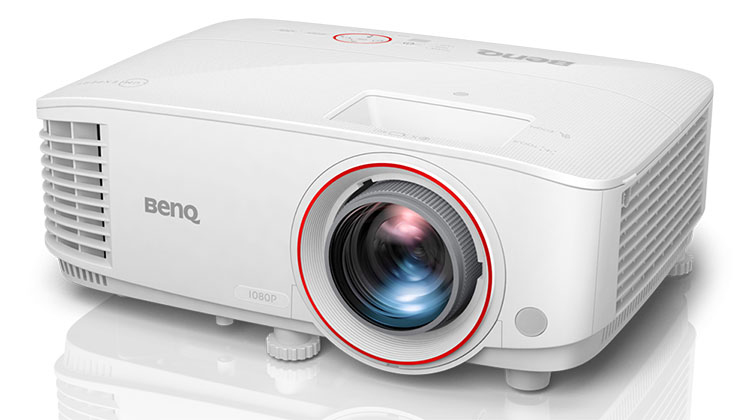
Gamers and movie buffs alike will love the BENQ TH671ST and its reasonable $749 price. It delivers a lot of performance for very little money.
- Bright sharp picture
- Excellent intra-image contrast
- Accurate color with or without calibration
- Convenient short-throw design
- Low input lag for superior gaming performance
- Backlit remote
- Larger zoom range and lens shift
Given its design parameters, there is really nothing to complain about here. The BenQ TH671ST delivers accurate Rec.709 color, superb clarity, bright imagery, and low input lag just as promised. Though 3D isn’t a big draw for consumers any longer, it still looks great on this projector. With a compact chassis and short-throw lens, it can be set up just about anywhere. It’s small enough to be portable but that also makes it ideal for smaller media rooms where one might not have 10 or 15 feet of depth to throw a 100” image. The TH671ST can do it from just five feet away, on a coffee table, or hung from the ceiling.
Some sub-$1000 displays give up accuracy or flexibility to keep costs in check but not this BenQ. Not only does it deliver impressive Rec.709 accuracy out of the box, it calibrates to an even higher standard. I achieved test results for grayscale tracking, gamma, and color that rival the best projectors I’ve reviewed. And if gaming is important to you, an 11ms input lag score puts it on par with some of the better gaming monitors I’ve tried.
It’s not Ultra HD and it doesn’t do HDR or extended color. But the BenQ TH671ST delivers some of the best high-definition imagery I’ve seen from such a reasonably-priced display. Those for whom space and budgets are tight will want to give it a serious look. Highly Recommended.




